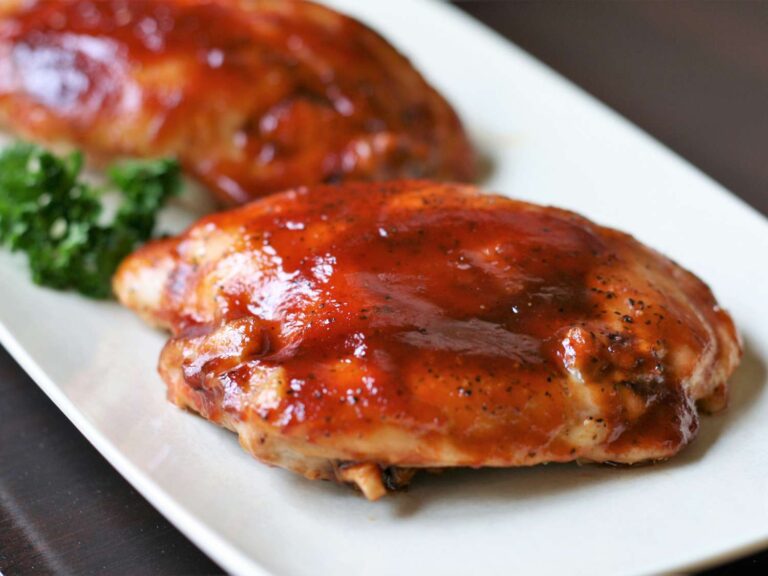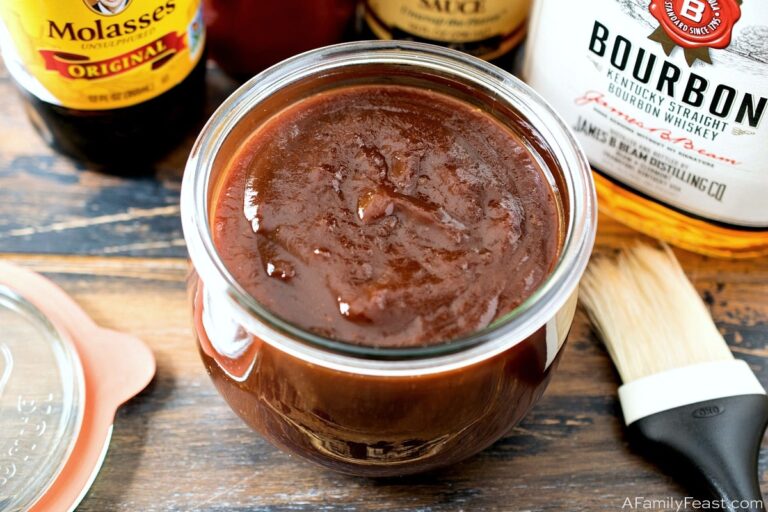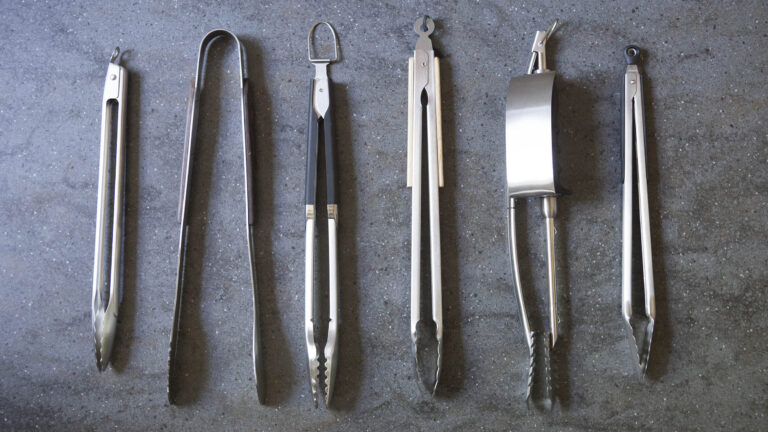The Best Guide to BBQ Chicken Thigh Calories
Craving the irresistible taste of BBQ chicken thighs but worried about calories? Fear not! Dive into the delightful world of BBQ chicken thigh Calories, where flavor meets health in a delicious balance. Each succulent bite offers a burst of smoky sweetness, making it a favorite at any table. But here’s the good news: you can enjoy this mouthwatering delight without derailing your health goals. Surprisingly, BBQ chicken thighs can fit into a balanced diet with ease. So, are you ready to discover how you can relish this culinary treat and still keep your calorie count in check? Let’s embark on this tasty journey together!
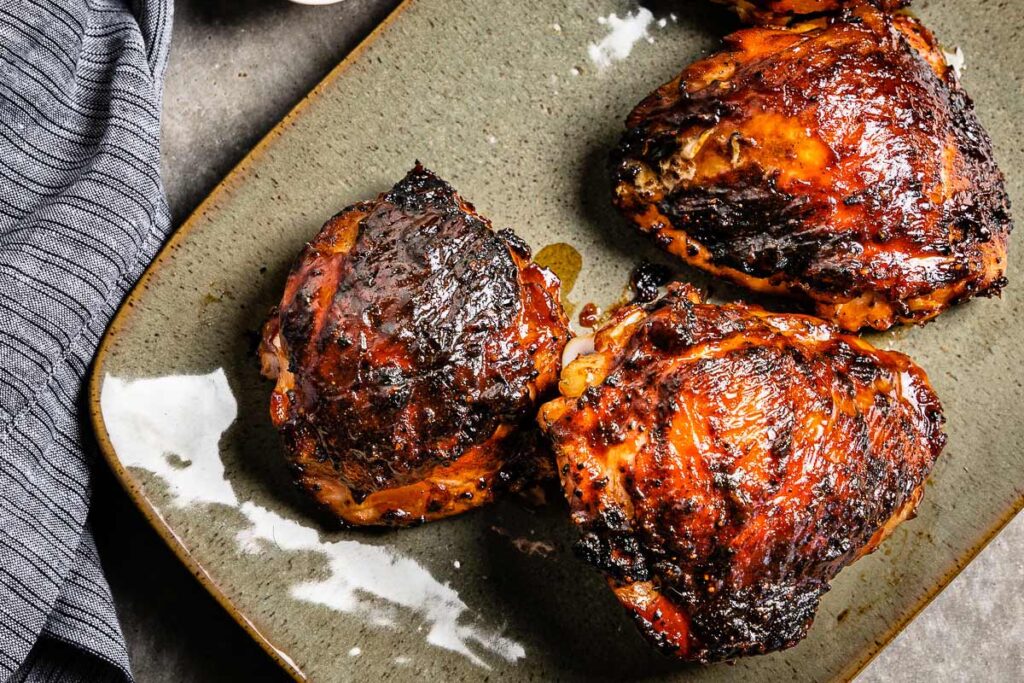
What is BBQ Chicken Thighs?
BBQ Chicken Thighs are more than just a dish; they’re a culinary experience that tantalizes the taste buds with a perfect blend of tenderness and flavor. These are chicken thighs – the portion between the knee and the pelvis of the bird – that have been seasoned, often marinated, and then cooked with the art of barbecue.
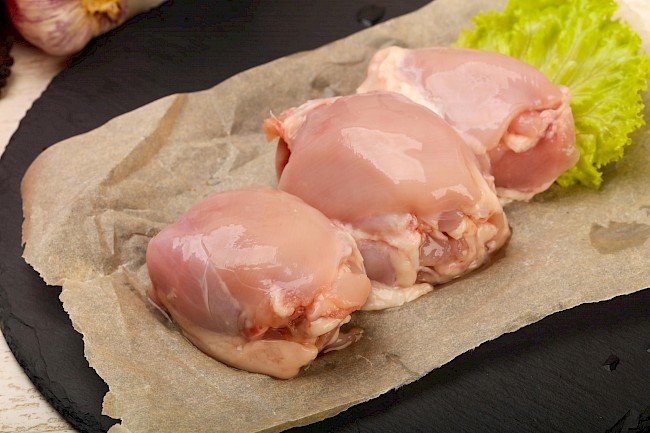
This cooking technique involves grilling or smoking the chicken, infusing it with a unique smoky flavor that’s synonymous with comfort and festivity. The thighs are known for their juicier and more flavorful profile compared to other chicken cuts, making them a beloved choice for BBQ enthusiasts. Whether slathered in a rich, tangy barbecue sauce or seasoned with a special rub, BBQ chicken thighs are a versatile dish that can be adapted to a wide range of tastes and styles.
What are BBQ Chicken Thigh Calories?
BBQ Chicken Thigh Calories refer to the amount of energy measured in calories that is contained in a serving of barbecue (BBQ) chicken thighs. This count varies depending on several factors:
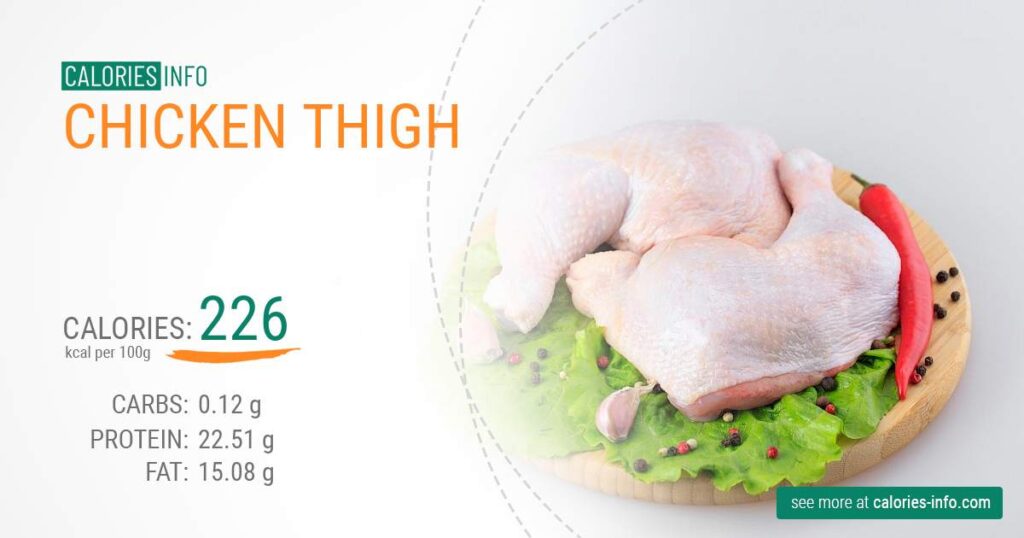
- Size of the Chicken Thigh: Larger thighs contain more meat and therefore more calories.
- Skin On or Off: Chicken thighs with the skin on have more calories due to the fat in the skin.
- Cooking Method: The way the chicken is cooked can affect its calorie content. BBQ chicken is typically grilled, which doesn’t add extra calories unless additional oil or butter is used.
- Marinade or BBQ Sauce: The type and amount of sauce or marinade used can significantly affect the calorie count. BBQ sauces often contain sugar, which adds to the calorie content.
- Preparation: Additional ingredients, like oil for basting or a breadcrumb coating, will increase the calorie count.
On average, a skinless, boneless BBQ chicken thigh can range between 200 to 250 calories, while a skin-on thigh can be around 250-300 calories. However, these numbers can vary based on the above factors, especially the type and amount of BBQ sauce used.
Are BBQ Chicken Thighs Better than Breast?
Whether BBQ chicken thighs are “better” than chicken breasts depends on personal preferences and specific dietary goals. Here’s a comparison to help you decide based on different criteria:
Taste and Texture:
- Chicken Thighs: They are known for their richer, more intense flavor due to higher fat content. Thighs remain juicy and tender when cooked, making them a favorite for grilling and BBQ.
- Chicken Breasts: These are milder in flavor and can dry out more easily if overcooked. However, they serve as a great canvas for a variety of flavors and seasonings.
Nutritional Content:
- Chicken Thighs: Higher in fat and calories but also richer in iron and zinc. The fat content adds to the flavor, which is why thighs are often preferred for BBQ.
- Chicken Breasts: Leaner with fewer calories and less fat. They are a great source of lean protein, making them a popular choice for weight management and fitness-oriented diets.
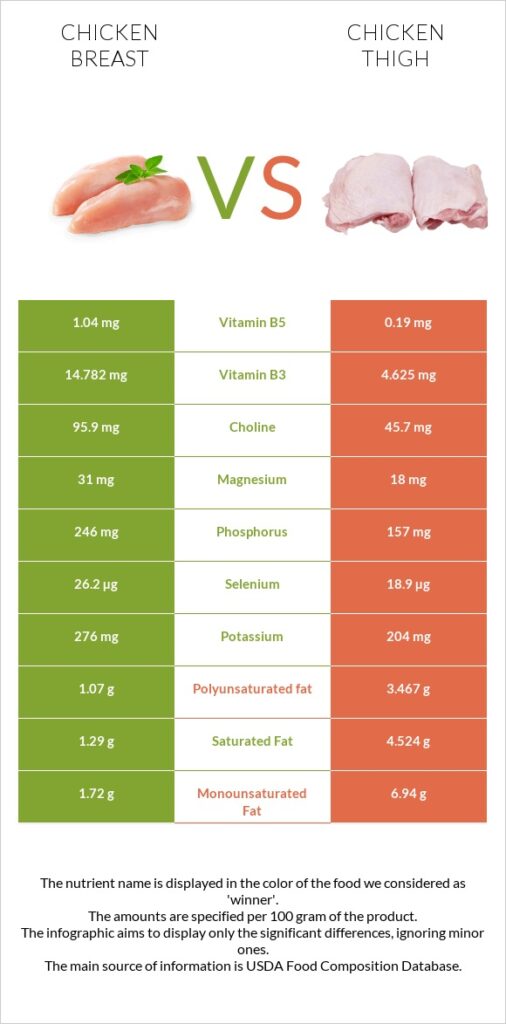
Cooking Versatility:
- Chicken Thighs: More forgiving and less likely to become dry or tough when overcooked. Their rich flavor makes them suitable for slow cooking, grilling, and frying.
- Chicken Breasts: Require more careful cooking to avoid dryness but are incredibly versatile for baking, grilling, stir-frying, and more.
Dietary Considerations:
- If you’re watching your calorie intake or seeking lean protein, chicken breasts might be preferable.
- If you’re looking for more flavor and don’t mind the extra fat, thighs might be your choice, especially for BBQ.
Ultimately, the choice between BBQ chicken thighs and breasts boils down to your personal taste preferences and nutritional needs. Both cuts offer valuable nutrients and can be part of a balanced diet.
How Do You Count Calories in Chicken Thighs?
Counting calories in chicken thighs involves considering a few key factors:
- Weigh the Chicken: The most accurate way to count calories is by starting with the weight of the chicken thigh. Use a kitchen scale to weigh the thigh either raw or cooked, as nutritional information can differ between the two states.
- Bone-in vs. Boneless: Determine if the thigh is bone-in or boneless. Boneless thighs have more meat and therefore more calories for their weight.
- Skin-on vs. Skinless: Check if the skin is on or off. The skin adds significant calories due to its fat content.
- Cooking Method: Consider how the chicken is cooked. Grilling, baking, or boiling usually adds no or very few extra calories, while frying or cooking in oil or butter increases the calorie count.
- Use Nutritional Data: Refer to nutritional databases or food labels for the average calorie content of chicken thighs based on these factors. For example, a raw, skinless, boneless chicken thigh might have about 120 calories per 100 grams, while the same thigh with skin might have more.
- Calculate Based on Weight: Multiply the average calorie content per unit of weight by the actual weight of your chicken thigh. For example, if a skinless, boneless thigh weighs 150 grams and the average calorie content is 120 calories per 100 grams, the calculation would be 150 g x (120 kcal/100 g) = 180 kcal.
- Consider Added Ingredients: If you add marinades, sauces, or oils, you’ll need to include their calorie content as well. Check the nutritional information for these items and add it to your total.
How Many Calories are in a Barbecue Chicken Thigh?
The number of BBQ Chicken Thigh Calories can vary depending on several factors, including the size of the thigh, whether the skin is on or off, and the ingredients used in the barbecue sauce.
Here’s a general breakdown:
- Skinless, Boneless Chicken Thigh: A typical skinless, boneless chicken thigh (about 52 grams) contains around 130 to 140 calories.
- With Skin: If the chicken thigh is cooked with the skin on, the calorie count can be significantly higher due to the fat in the skin.
- Barbecue Sauce: The type and amount of barbecue sauce used can also add calories. Commercial barbecue sauces often contain sugar and fat, which can increase the calorie count.

As a rough estimate, a skinless, boneless BBQ chicken thigh might contain between 150 to 200 calories, considering the added calories from the sauce. However, if the thigh is larger, has skin, or is coated in a generous amount of sauce, the calorie content could be higher. It’s always best to refer to the specific nutritional information for the exact product or recipe you’re using for the most accurate count.
Health Benefits of BBQ Chicken Thigh Calories
BBQ chicken thighs, when consumed in moderation and prepared healthily, can offer several health benefits:
- Rich in Proteins: Chicken thighs are an excellent source of high-quality protein, which is vital for muscle building, repair, and overall body function.
- Contains Essential Vitamins and Minerals: They provide important nutrients like B vitamins (B6 and B12), which are crucial for energy production and maintaining healthy nerve and blood cells. They also contain minerals like zinc and selenium, important for immune function and thyroid health.
- More Flavorful and Satisfying: Due to their higher fat content compared to chicken breasts, thighs can be more satisfying and flavorful. This can lead to greater meal enjoyment and satiety, which might help with portion control and overall dietary satisfaction.
- Flexible in Healthier Cooking Methods: When BBQ’d, chicken thighs can be cooked in a way that minimizes added fats, making them a healthier choice compared to fried or heavily sauced meats.
- Good for Weight Management: If portion sizes are controlled, the protein richness of chicken thighs can help in weight management by providing a feeling of fullness, reducing the likelihood of overeating.
- Heart Health: Choosing skinless chicken thighs and using healthy marinades or spices can make this a heart-friendly option, as it reduces the intake of saturated fats.
- Iron Content: Chicken thighs are a good source of heme iron, the type of iron that is more easily absorbed by the body, which is beneficial for preventing anemia and improving energy levels.
- Versatility for Balanced Eating: Their versatility in recipes allows them to be paired with a variety of healthy sides like vegetables, whole grains, and salads, making it easier to create a balanced, nutrient-rich meal.
Nutritional Info of BBQ Chicken Thigh Calories
The nutritional information of a BBQ Chicken Thigh Calories can vary based on several factors like the size of the thigh, whether it’s skinless or skin-on, and the type and amount of BBQ sauce used. Here’s a general breakdown for a typical BBQ chicken thigh:
Nutritional Info for a Skinless, Boneless BBQ Chicken Thigh:
- Weight: Approximately 100 grams
- Calories: Roughly 200-250 kcal
- Protein: About 20-25 grams
- Total Fat: 10-15 grams
- Saturated Fat: 2-3 grams
- Cholesterol: 70-80 mg
- Sodium: This can vary widely depending on the BBQ sauce used; approximately 400-500 mg
- Carbohydrates: 5-10 grams (mostly from the BBQ sauce)
- Sugars: 4-8 grams (from the BBQ sauce)
- Fiber: Minimal to none
- Vitamins and Minerals: Small amounts of iron and B vitamins
Nutritional Info for a Skin-on, Boneless BBQ Chicken Thigh:
- Calories: Higher than the skinless version, approximately 250-300 kcal
- Total Fat: Significantly higher due to skin; about 15-20 grams
- Other Nutrients: Similar to the skinless version but with increased fat content.
Notes:
- These values are approximate and can vary.
- The calorie count can increase with additional sauce or if the chicken is cooked with added oils or fats.
- BBQ sauces can vary significantly in sugar and sodium content, impacting the total calorie and carbohydrate count.
- For specific dietary tracking, it’s best to look at the nutritional information on the packaging of the BBQ sauce and chicken used, or use a nutritional database with information tailored to the specific recipe or product.
Remember, while BBQ Chicken Thigh Calories can be a delicious and protein-rich part of a meal, balancing them with plenty of vegetables and whole grains can make for a more nutritionally complete and satisfying meal.
FAQs:
- Are BBQ chicken thighs healthy?
Yes, in moderation. They are rich in protein and essential nutrients but watch the fat content and the type of BBQ sauce used to manage calorie intake. - Can BBQ chicken thighs fit into a weight loss diet?
Yes, if portion sizes are controlled and they are prepared healthily (e.g., skinless, minimal added sugars and fats). - What nutrients are in BBQ Chicken Thigh Calories?
They contain protein, B vitamins, iron, zinc, and depending on preparation, varying amounts of fat and carbohydrates. - How can I make BBQ chicken thighs healthier?
Use skinless thighs, opt for low-sugar BBQ sauce, and balance your meal with vegetables and whole grains. - Is it better to choose chicken thighs or breasts for BBQ?
It depends on personal preference and dietary goals. Thighs are more flavorful and moist, while breasts are leaner. - How should I cook BBQ chicken thighs to keep them healthy?
Grill or bake them instead of frying, and be mindful of the amount and type of BBQ sauce used. - Can I include BBQ chicken thighs in a muscle-building diet?
Absolutely. Their high protein content makes them ideal for muscle repair and growth. - Are BBQ chicken thighs suitable for a low-carb diet?
Yes, especially if you choose a low-sugar BBQ sauce and remove the skin. - How do I calculate the calories in homemade BBQ chicken thighs?
Weigh the ingredients, including the chicken and sauce, and use nutritional databases or labels for calorie counts, then add them up.


